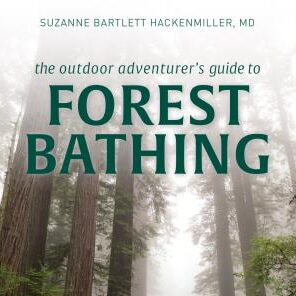The Outdoor Adventure’s Guide to Forest Bathing
Susan’s book melds forest bathing, mindfulness, and outdoor activities.
In the introduction of the book, she writes about the origins of forest therapy and the standard sequence of invitations developed by Amos Clifford.
An invitation is a suggestion on how to take advantage of the healing powers of nature by immersing yourself in the present moment.
Each subsequent chapter adapts and introduces additional invitations to the particular sport.
These invitations are meant to be done before, during, and after your sport.
In one example, before you begin paddle boarding, scoop up the water in your hands and notice the properties of the water. What is the temperature of the water in relation to your hands? What is the weightiness of the water in your hands?
Each chapter has a helpful suggestion for a plant to use in the tea ceremony that closes out a forest bathing experience.
Interspersed throughout the book she includes athlete testimonials. These athletes further back up the belief of the importance of spending time in nature.
In the back of the book is a Resource and Recommended Reading List for further study. She also included an appendix on How to Create a Tea Ceremony.
What I got from The Outdoor Adventurer’s Guide to Forest Bathing is that through forest bathing you can slow down into the mindfulness and the physical properties of the outdoors that benefit your health and wellbeing.
Forest bathing is traditionally done while on slow walks or strolls.
Hackenmiller proves that forest bathing can be done in a variety of faster-paced outdoor adventures.
Although I personally do not go on super long hikes, paddle, mountain bike, climb, cross country ski, or trail run, I found a lot of value in this book. I imagine that if you participate in any, or all of these sports, you will find even more value than I did.”

